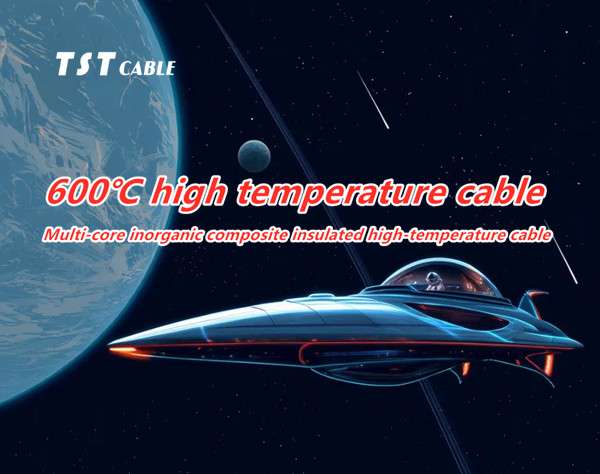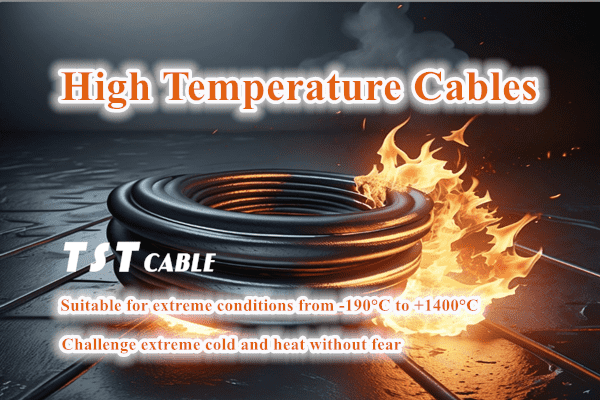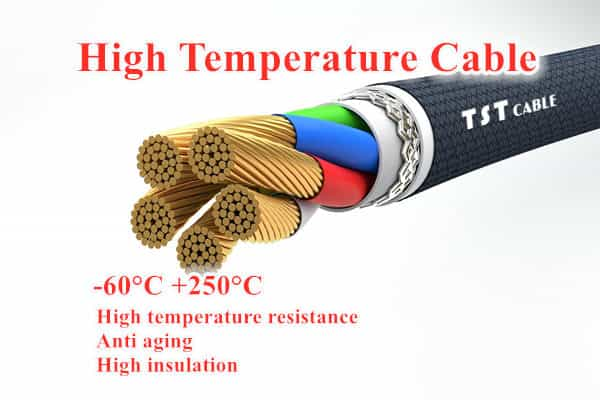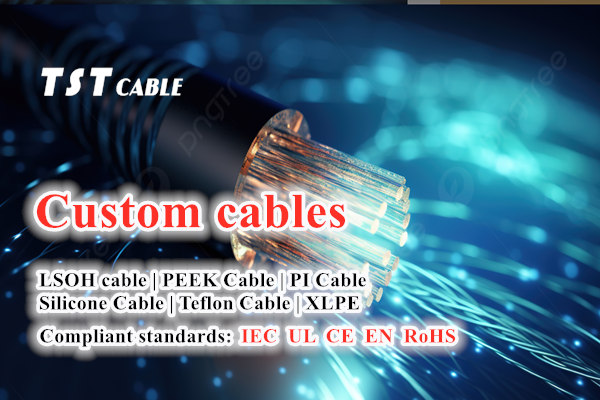In the fields of aviation and aerospace, sensor arrays of aircraft engines, rocket engines, etc., and core circuit systems of deep space probes, a seemingly ordinary cable is guarding the “lifeline” of modern industry with a steel-like will. When ordinary cables gradually soften, age, or even melt under high temperatures of hundreds of degrees Celsius, the TH/J-GWHP series 600℃ high-temperature cables independently developed by TST cable can operate as stable as a rock, occupying the commanding heights of global high-temperature cable technology with extreme performance. Behind this is a technological revolution in materials science, structural engineering and extreme challenges, and it is also a technological charge launched by a Chinese company to the core areas of global industry.

High-temperature battlefield: the dilemma of the “lifeline” of modern industry
In the aircraft engine compartment, the temperature dynamically rises to more than 600℃ with the working state; in the thermal management system of new energy vehicle batteries, extreme temperature differences test every transmission line; next to the steel smelting kiln, the double attack of corrosive gases and high temperatures makes traditional cables overwhelmed. These scenarios put forward almost “impossible” requirements for cables: they must not only withstand the low temperature of -60℃, but also maintain signal stability in the flames of 600℃ Heat resistant cable, and even face the ultra-high temperature “test” of 800℃ for a short time. The problems of traditional cables such as melting of insulation layer, oxidation of conductors, and signal attenuation at high temperatures are like the sword of Damocles hanging over the heads of industrial systems. The emergence of TST cableTH/J-GWHP series cables is precisely to cut off this “high temperature sword”.
Technical breakthrough: TST cable’s high temperature cable “black technology”
The TST cable team developed this subversive high temperature cable with “reliability under extreme working conditions” as the core goal. Its technological breakthroughs can be summarized as four “black technologies”:
1Material innovation: the secret of multi-core inorganic composite insulation
The insulation layer of the cable adopts a multi-layer inorganic material composite structure, such as high temperature resistant materials such as alumina and mica, which are laminated and wrapped by special processes. This design not only withstands high temperatures, but also maintains mechanical strength at extreme temperatures to avoid cracking of the insulation layer caused by thermal expansion and contraction. At the same time, the high dielectric constant of inorganic materials ensures signal transmission stability and reduces electromagnetic interference. It is worth noting that the combination of different inorganic materials needs to be precisely calculated to ensure high temperature resistance and avoid chemical reactions between materials at high temperatures. This is a key breakthrough in the research and development process.
2 Structural optimization: balance between miniaturization and flexibility
To meet the needs of narrow spaces, the cable adopts a “tight twisting + flexible filling” structure. The conductor uses high-strength materials such as pure nickel wire and copper-nickel-copper alloy wire to ensure conductivity and maintain structural stability at high temperatures; high-temperature resistant flexible materials are filled between the insulation layer and the sheath layer, so that the cable bending radius reaches 2-3D (2-3 times the cable diameter), achieving flexible wiring and avoiding stress damage caused by bending. In addition, by optimizing the twisting angle and layer spacing, the cable can effectively disperse pressure and improve tensile resistance when subjected to mechanical stress.
3 Environmental adaptability: comprehensive protection from damp heat to vibration
The cable has passed a number of rigorous tests: damp heat test (30℃~60℃, 10 cycles at 95% relative humidity) to ensure that the insulation resistance is ≥20MΩ·km in a humid environment to prevent leakage; no stray powder falls during the vibration test to avoid signal interference or short circuit caused by vibration; low smoke and halogen-free fireproof design (in compliance with GB/T19666-2019) to reduce the release of toxic gases in fires and improve safety. It is worth noting that the cable uses a composite vibration mode (such as sinusoidal vibration + random vibration) that simulates actual working conditions in the vibration test to ensure its reliability in complex mechanical environments.
4 Conductor material selection: conductive stability at high temperatures
The selection of conductor materials is crucial. Pure nickel wire has excellent oxidation resistance and mechanical strength at high temperatures, but has a high resistivity; copper-nickel copper alloy wire optimizes the ratio of copper to nickel to balance conductivity and heat resistance; nickel-chromium alloy wire and nickel-silicon alloy wire provide higher corrosion resistance in specific scenarios. For different application scenarios, the R&D team will customize the selection of conductor materials, such as using copper-nickel copper alloy wire in power transmission scenarios that require high conductivity, and using nickel-chromium alloy wire in corrosive environments. This material strategy greatly improves the applicability of the cable.
Performance decoding: Conquering high temperature limits with data
The technical parameters are an intuitive reflection of the “hard power” of TST cable:
Extreme temperature tolerance
Long-term working temperature 600℃, short-term extreme temperature 800℃ (30 minutes), this indicator breaks the international record of similar products;
Insulation stability
Insulation resistance ≥200MΩ·km at 20℃, still ≥20MΩ·km at 400℃, ensuring zero attenuation of signal transmission;
Safety design
Passed the GB/T19666-2019 low-smoke and halogen-free fire protection test, reducing the release of toxic gases in fires;
Miniaturized size
The total outer diameter of the 4 cores is ≤6mm, and the conductor resistance is as low as 45.6Ω/m, taking into account both lightweight and low energy consumption.
Behind these data are thousands of high-temperature aging tests, vibration simulation experiments and material formula optimization conducted by TST cable laboratory.
In the process of developing high-temperature cables, the team faced many technical challenges. For example, how to achieve the flexibility of the cable while ensuring high-temperature resistance? The R&D team mixed rigid inorganic materials and flexible fillers in a specific proportion through material composite technology, and finally achieved flexibility at high temperature through multiple extrusion molding process optimization. For example, how to ensure that the conductor does not oxidize during the short-term tolerance of 800℃? The team developed a multi-layer protective structure. This “sandwich” structure effectively isolates oxygen and prolongs the life of the conductor.
Application scenario: “battlefield” of high-temperature cables
Aerospace engine measurement and control system
In the engine compartment, the temperature changes dynamically with the working state and can reach more than 600℃. TH/J-GWHP cable can transmit sensor signals in extreme environments and monitor parameters such as temperature and pressure in real time. Its high-temperature resistance ensures that the signal is not distorted during high heat load stages such as startup and acceleration, providing key data support for flight safety. In addition, the miniaturized design of the cable enables it to fit the compact structure of the engine, avoiding installation difficulties caused by insufficient wiring space.
Signal transmission of industrial high-temperature equipment
In industrial scenarios such as steel smelting and glass manufacturing, the temperature of the kiln often reaches hundreds of degrees Celsius. The miniaturized design of the cable enables it to fit the equipment structure wiring and transmit control signals and temperature detection data. For example, in a glass kiln, the cable needs to work for a long time in an environment above 500°C, and its acid and alkali resistance resists the erosion of corrosive gases (such as SO₂, HCl, etc.) in the industrial environment, extending the equipment maintenance cycle.
Aircraft and satellite temperature control system
In the spacecraft cabin, the temperature changes extremely drastically, from the low temperature at launch to the extreme temperature difference in space, which places extremely high demands on the cable’s resistance to high and low temperature cycles. TH/J-GWHP cable has passed the wide temperature range test of -60°C to 600°C to ensure stable signal transmission in extreme space environments. In addition, its low smoke and halogen-free characteristics are particularly important in a closed cabin to avoid the release of toxic gases in the event of a fire that threatens the safety of astronauts.
Positioning at the commanding heights: TST cable’s technical barriers and global vision
How can TST cable achieve “overtaking on the curve” in the context of long-term monopoly of the high-temperature cable market by European and American companies?
01 Technical patent moat
Apply for a number of international patents around core technologies such as high-temperature resistant material formulas and multi-layer composite insulation structures to build technical barriers;
02 Scenario customization capabilities
From aviation to industry, from power transmission to temperature compensation, it provides full-scenario solutions, and its customers include Fortune 500 and well-known domestic companies.
03 Extreme testing system
Self-built high-temperature aging laboratory to simulate the full temperature range of -60℃ to 800℃ to ensure that every cable reaches “battlefield-level” reliability when it leaves the factory;
04 Cost and efficiency advantages
Through localization of materials and process innovation, it achieves performance that exceeds imported cables while reducing costs by 30%, forming a dual advantage of “cost-effectiveness + technological leadership” in global competition.
Conclusion
TST cableTH/J-GWHP series 600℃ high-temperature cables build a signal transmission fortress under extreme temperatures with material innovation, structural optimization and rigorous testing. Its technological breakthrough not only fills the gap in the high-temperature cable market, but also provides key basic components for extreme environment applications in the fields of industrial upgrading, energy revolution, aerospace, etc. In the field of “temperature is a challenge”, this cable is reshaping the limit with technological breakthroughs, becoming a signal guardian in the high-temperature battlefield, and providing solid technical support for human exploration of more severe environments.
Also available in:
English




